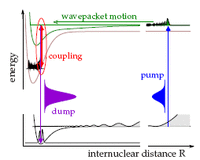 |
Forming ultacold molecules by an optical pump-dump scheme
CoPoMol principal investigator Robert Moszynski and Christiane P. Koch at the Freie Universitat Berlin, report on an all-optical way of producing ultracold molecules. The idea is based on a two-colour mechanism where the laser source is used to pump colliding atoms to an electronic excited state with a large internuclear distance. The wave-packet formed in such a way evolutes towards a situation where atoms are brought closer at a shorter-nuclear distance. A second laser is used to couple two otherwise isolated excited-state potentials and stabilize the molecule in a ground electronic state. The prototype system used in this study is the 40Ca2 dimer and the infrared lasers employed typically emit nanosecond pulses with a few picoseconds full-width at half maximum (FWHM). Coupling between electronic states is achieved by accurately tuning laser field wavelengths and intensities. This method can be applied generally to enhance transition probabilities in Raman-like pulsed schemes and beyond.
These results have been published in Physical Review A 78, 043417 (2008).
 |
Prospects for sympathetic cooling of NH3 molecules
Dr. Piotr Zuchowski and Professor Jeremy Hutson from the CoPoMol Collaborative Research Project have theoretically investigated a way of producing ultracold (below 1mK) NH3 molecules by sympathetic cooling. This technique relies on a thermalization between ultracold molecules and a lower-temperature gas of ultracold atoms. Elastic collisions between the species redistribute the energy and result in the cooling of the molecules. Candidate system for this study are NH3 molecules and alkali- or alkaline-earth metals atoms for which the combination of laser cooling and Stark deceleration techniques can be used experimentally. Potential energy profiles have been calculated by ab initio methods showing that sympathetic cooling for these species may occur if very specific energetic and symmetry conditions are fulfilled. These results open the way to a better understanding of collision mechanisms between ultra cold atoms and molecules.
The article has been published in Physical Review A, 78, 022701 (2008).

